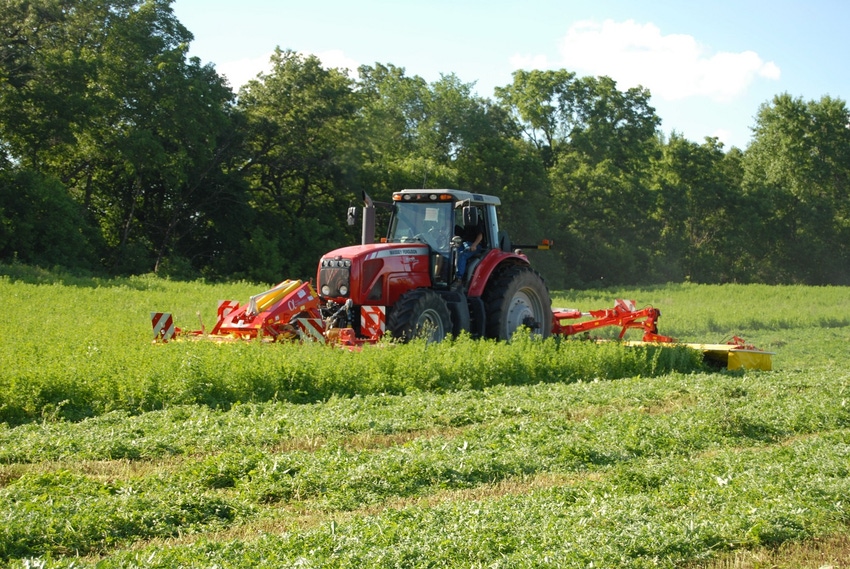May 1, 2019

If your cow-calf operation seeks the most economical production methods, haying must be considered for elimination because it is such a large portion of most budgets. This is true whether the hay is raised or purchased.
Many people all over the U.S. manage to eliminate or drastically reduce hay feeding, so this is not an academic question. From that realization should spring the many questions about how to do it.
In the Southeast, a feasible alternative to hay is stockpiled warm-season perennial grasses such as bermudagrass, says Larry Redmon, Texas A&M AgriLife Extension agronomist. “Stockpile by grazing a pasture to a short height six to eight weeks prior to first frost," he says. "Apply 50 to 60 pounds of nitrogen plus phosphorus and potassium, if recommended on a soil analysis report. Remove cattle from the pasture to allow forage growth. Begin controlled grazing after first frost.”
Strip grazing is an excellent way to control grazing and provide better forage utilization than giving cattle continual access. Strips across the pasture or a section of the pasture are created with a single-wire electric fence, providing enough forage to carry the herd for up to three days. The number of days can vary depending on how often the producer wants to move the fence and how much utilization he wants. Consensus is that moving the fence at least every three days provides the best forage utilization and better maintains body condition by keeping cows on quality forage.
Redmon suggests cows calving in the late winter/early spring timeframe are ideal for grazing stockpiled forage because dry, pregnant cows typically have the lowest nutrient requirements. A dry cow only needs approximately 8% protein to maintain body condition and it is not uncommon for bermudagrass to contain 11% protein well into January.
Redmon adds that cows in other reproduction stages can perform well on stockpiled forage if grass nutrient values are sufficient or an appropriate supplement is fed. Nutrient requirements can also be met by alternating cattle between stockpiled forage and winter pastures such as clover/annual ryegrass pastures.
A chart of cost comparison between feeding hay and stockpiling forage is shown with this story. The data, provided by Redmon, shows a savings of $44 per cow from stockpiling. Hay costs are assumed to be put up by the beef producer. Chemical costs include herbicides and insecticides, whereas supplies include bailing twine and miscellaneous expenses. Depreciation, fuel, repair and maintenance all pertain to the hay equipment.
Total cost of hay for 45 days is based on a 1,200-pound cow consuming about 3% of her body weight in dry matter. She would eat approximately 39 pounds of hay daily at six cents per pound ($120.04 ÷ 2,000 pounds per ton = $.06). Each producer should draft his/her own comparison using appropriate costs.
If you plan to strip graze, cost of electric fencing (materials plus labor) needs to be added to the stockpiled forage column.
Other options
Here is a brief discussion of other options for various pasture types during each of the four grazing seasons.
Again, in southern states and depending on fall temperatures in October through December, options are to graze growing bermudagrass, stockpiled bermudagrass or warm-season perennial native grass. Examples of warm-season grasses are bluestems, common bermudagrass, and native grasses such as eastern gamagrass, Indiangrass, side-oats grama and switchgrass.
In southern states in the winter, meaning January through early March, additional options are feeding hay, feed and/or plant byproducts, or limit grazing on a cereal grain such as oats, wheat or rye.
During late March through May, the spring grazing season, options include annual ryegrass, a forage legume, cool-season perennial native grasses or feeding hay. Annual ryegrass and a cereal grain forage can be planted in the same pasture at the same time to provide winter and spring grazing. Depending on the geographical area, cool-season grasses can include tall fescue, Kentucky bluegrass, orchard grass, smooth bromegrass or timothy.
Options for summer grazing, which is June through September, include introduced warm-season grasses such as common or hybrid bermudagrasses, bahiagrass or dallisgrass. Varieties of seeded hybrid bermudas include Arizona Common, Cheyenne, Wrangler and Giant. Examples of sprigged varieties are Midland 99, Midland, Coastal, Tifton 44 and Tifton 85. In some areas, hay feeding creeps into summer, as well. Grazing management is usually the most economical answer for this condition, as well.
Depending on location, stockpiled forages combined with grazing management have significantly reduced wintering costs versus haying. This can include strip grazing of native range, strip grazing of cover crops, windrow grazing, bale grazing, and stockpiled and strip-grazed fescue or other perennial cool-season forages.
Fears writes from Plano, Texas.
About the Author(s)
You May Also Like




